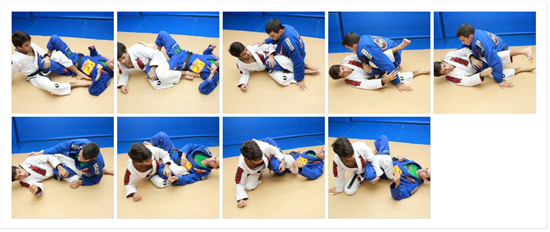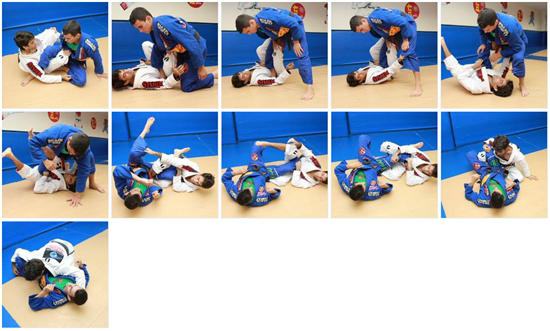CLICK HERE TO SEE THE ENTIRE COURSE , if you are new, REGISTER FREE (Click HERE) and use the code BBBFREETRIAL to watch this techniques and many more!
5050 is a controvertial technique, some love, some hate. As a BJJ competitor and coach, I prefer to leave those emotions out of it and make sure I understand the new techniques, just by having a good understanding of it I can choose whether it applies to my game or not and if I face someone who loves doing it, I know what to expect and how to defend.
By having a good understanding of 5050, when I face someone who is clueless about it (maybe because that person choose to adopt the "I hate, I dont need"posture), it usually means I will play with that person and make 5050 look more like 100% in my favor. If it happens that I face a opponent that is also familiar with it, that normally means the strategie will take place and experience and little details may make the difference towards the winner.
It's a mistake to think 5050 is made for stall, it's not. What happen is that when 2 fighters have similar knowledge about it, it becomes very hard to progress, cause the position allow both sides to use the same principles.
Well, this is the least I demand my students to know, hope you can benefit from it:
Click on the picture to see the video:

Technique 1 (VIDEO HERE):
First is important to understand what you should look for once you fall on the 5050, by undertanding this, your chances of progressing will increase, so check out this first details on how to behave if you find yourself there:
1 & 2)
Make sure your left hand control your opponent's knee, that way is not easy for him to step out of this "trap", also start to face the outside, towards the opposite leg that is trap (to your right on this picture)
Squeese your legs together for extra control, face completely to your right, in a way that he have no option to reset. Keeping your foot on his ribs may help preventing him from coming up.
3, 4, 5 & 6)
If you did everything correct up to this point, it will be difficult for him to come on top, but if he does, just completely stretch your left leg, parallel to the ground pushing him back, that way your weight will act on his hip will make impossible for him to establish top position.
7, 8 & 9)
Use that motion of putting your opponent butt back on the ground to bring your self back up, make sure to use the movement just like a technique stand up drill. It's important to open your right knee in a angle to get a better base and avoind your opponent turn to his right and take your balance away, just as you did with him.

Technique 2 VIDEO HERE:
Some times, your opponent is familiar with the basics too and become harder to stand up first, here is what to do if you are the one a step behind
1,2&3)
You were too late, your opponent managed to stand up, possibly because you fail to face the correct way and make your leg heavy on his hips, but you still have a chance.
4&5)
Reach for his leg that is not trap and make a grip close to his know with the palm of your hand facing up. That grip is important to make it easier to push later on, when he is falling
Use this same grip to help your head to approach that leg, making a movement as if you were going to pass under his legs
5&7)
Keep that motion, going with your head as if you will pass under his leg towards his back, when you feel he will start to loose balance, streach your right leg foward, following the line of your own body, that will be enough to make you fall
8,9,10&11)
Once he falls, do not follow his motion and come on top, if you do this he will trap you and maybe do the same back to you (I would only go up if I need to score and it's the last few seconds of the fight).
As you let him fall without going up, you will create space for your leg to retreat, take advantage of that moment and hide your foot and show on picture 9. Once you have done this, you will be able to come on top in a position similar to a leg drag and by putting pressure, big chances you will end up on his side control.

Technique 3 VIDEO HERE
Once you are comfortable with the first 2 techniques, you may get enough confidence to let your opponent move a bit more, once you do it, this is another option that turn to be a great short cut to get the back.
1&2)
Once you feel your opponent is try to stand up, let he do it and start to enter your left hook on his other leg, the one that is not trapped as if you are going towards the X guard.
3,4&5)
Once he stands up, swing your upper body to your left and that same hook will give you the extra leverage you need to move your head towards his back .
If you can, reach out for his pants, that grip will secure that he can't face you again, once he realize where he is getting him self at.
6&7)
Right grip on his knee will hold his leg still, so you can stretch your leg in a way it can be brought under his hips towards your leg.
8)
Keep your left grip, but let go your right grip towards his belt
9)
Make sure to keep your legs bend close to your body, using it was a chair/shield, since once your opponent falls back, that will protect you
10&11) Once he falls on your lap, keep your hooks active to control him while you make the transition of your arms to the "sit belt"control and later the hook in the traditional way.
This is a trick technique, the kind of technique you get everyone once and they ask what you did, of course you teach and never get them again, cause they don't do the same mistake. But it's still fun to know
1&2) if you notice your opponent is closing the leg with the triangle, hold his shin in a way he can no longer unlock
3&4)
bring you right leg and trap their foot as show
5, 6&7)
Now use your hand to pull their knee towards you at the same time you force your right leg. This will apply pressure on their calf. Remember that calf slicer are only allow for brown and black belts.
If they dont take, they may at least make space for you to take your leg out, as showed on the second technique
On techique 5, Im showing a common mistake people do and my training partner Erick Raposo will take advantage of it to apply a footlock
1)
My first mistake is to lock the triangle when in the 5050, that leads my opponent open to attach my foot
2)
Even worse would be to attack the foot of his leg that is trap, because since my back is on the ground, the motion to apply pressure is limited, also the fact that his leg is stretch, makes even harder. Of course is not impossible to get it, but the movement is limited, so it's harder.
3) notice that while I'm trying to attack his foot, my left foot is open near his hands
4&5) All he needs to do is lock it in and because I had the triangle close and his pressure in toward the angle that hurts the most, even if we are both attacking each other's foot, he will tap me out first.
CLICK HERE TO SEE THE ENTIRE COURSE , if you are new, REGISTER FREE ( Click HERE) and use the code BBBFREETRIAL to watch this techniques and many more